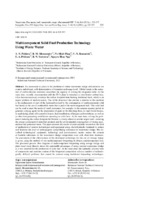| dc.contributor.author | Pekhota, A. N. | |
| dc.contributor.author | Khroustalev, B. M. | |
| dc.contributor.author | Phap, Vu Minh | |
| dc.contributor.author | Romaniuk, V. N. | |
| dc.contributor.author | Pekhota, E. A. | |
| dc.contributor.author | Vostrova, R. N. | |
| dc.contributor.author | Nga, Nguyen Thuy | |
| dc.coverage.spatial | Минск | ru |
| dc.date.accessioned | 2021-12-14T06:43:45Z | |
| dc.date.available | 2021-12-14T06:43:45Z | |
| dc.date.issued | 2021 | |
| dc.identifier.citation | Multicomponent Solid Fuel Production Technology Using Waste Water = Технология производства многокомпонентного твердого топлива с использованием отходов сточных вод / A. N. Pekhota [et al.] // Энергетика. Известия высших учебных заведений и энергетических объединений СНГ. – 2021. – № 6. – С. 525-537. | ru |
| dc.identifier.uri | https://rep.bntu.by/handle/data/108171 | |
| dc.description.abstract | An assessment is given to the problems of urban wastewater sludge utilization in our country and abroad, with determination of formation and usage level. Global trends in the reduction of carbon dioxide emissions exacerbate the urgency of solving the designated tasks. At the same time, recently, in connection with the EU’s plans to introduce a cross-border carbon levy, it has become necessary to reduce the carbon footprint from burning traditional fuels, which is an urgent problem of modern society. One of the directions that provide a solution to this problem is the replacement of part of the hydrocarbon fuel by the consumption of multicomponent solid fuel based on the use of combustible waste that is part of the multicomponent fuel. This solid fuel can be used to meet the needs of small consumers, for example, in the autumn-summer period to generate a drying agent for the preparation of grain on the threshing-floor, in small boiler houses, in sand drying plants of locomotive depots, heat installations of hangars and workshops, as well as in other heat-generating installations operating on solid fuels. At the same time, solving the problem of reducing the carbon footprint for Belarus is closely related to another urgent task – reducing the energy component of industrial products and the environmental consequences of storing accumulated and generated waste. The paper presents the results of joint scientific research in the field of application of modern technologies and equipment using electrohydraulic treatment to reduce and minimize the level of anthropogenic and polluting substances in wastewater sludge. The described technological equipment, technology and post-treatment modes reduce the content of harmful substances in the wastewater sludge composition even with short-term treatment. An assessment of the effectiveness of the developed technology for the use of sewage sludge is given, using the method of wet multicomponent briquetting to obtain a multicomponent fuel. The presented process flow diagram of multicomponent briquetting using sewage sludge and plant-wood waste directly shows the undeniable advantages of using watered wastewater sludge as a raw material for the production of solid fuel. At the same time, the optimally selected ratio of components and moisture content of the briquetted composition solves a number of technologically difficult problems that cannot be realized using traditional briquetting technologies. The presented data of the conducted research and the developed technology make it possible to expand the area of using wastewater sludge as a secondary renewable material resource. | ru |
| dc.language.iso | en | ru |
| dc.publisher | БНТУ | ru |
| dc.title | Multicomponent Solid Fuel Production Technology Using Waste Water | ru |
| dc.title.alternative | Технология производства многокомпонентного твердого топлива с использованием отходов сточных вод | ru |
| dc.type | Article | ru |
| dc.identifier.doi | 10.21122/1029-7448-2021-64-6-525-537 | |
| local.description.annotation | Дана оценка проблемам утилизации осадков городских сточных вод в Беларуси и за рубежом с определением уровня их образования и использования. Мировые тенденции сокращения выбросов диоксида углерода обостряют актуальность решения указанных задач. В связи с планами Европейского союза по введению трансграничного углеродного сбора возникла необходимость снижения углеродного следа от сжигания традиционных видов топлива, что является актуальной проблемой для современного общества. Одно из направлений ее решения – замещение части углеводородного топлива многокомпонентным твердым на основе горючих отходов. Твердое топливо можно использовать для обеспечения нужд мелких потребителей, например в осенне-летний период для генерации сушильного агента при подготовке зерна на токах, на мелких котельных, в сушильных установках песка локомотивных депо, теплоустановках ангаров и мастерских, а также в иных теплогенерирующих установках. При этом для Беларуси снижение углеродного следа тесно связано с другой актуальной задачей – уменьшением энергетической составляющей промышленной продукции и экологических последствий хранения накопленных и образующихся отходов. В статье представлены результаты совместных научных исследований в области применения современных технологий и оборудования, использующих электрогидравлическую обработку для снижения и минимизации уровня содержания антропогенных и загрязняющих веществ в осадке сточных вод. Описанные технологическое оборудование, технология и режимы доочистки позволяют снизить содержание вредных веществ в осадке сточных вод даже при кратковременной обработке. Дана оценка эффективности разработанной технологии использования осадка сточных вод с применением метода влажного многокомпонентного брикетирования для получения многокомпонентного топлива. Представленная принципиальная технологическая схема многокомпонентного брикетирования с использованием осадка сточных вод и растительно-древесных отходов показывает неоспоримые преимущества применения обводненного осадка сточных вод в качестве сырья для производства твердого топлива. При этом оптимально подобранное соотношение компонентов и влажности брикетируемого состава решает ряд технологически трудных задач, не реализуемых с помощью традиционных технологий брикетирования. Проведенные исследования и разработанная технология позволяют расширить область использования осадков сточных вод в качестве вторичного возобновляемого материального ресурса. | ru |

